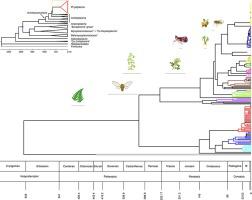当前位置:
X-MOL 学术
›
Mol. Phylogenet. Evol.
›
论文详情
Our official English website, www.x-mol.net, welcomes your
feedback! (Note: you will need to create a separate account there.)
A timetree for phytoplasmas (Mollicutes) with new insights on patterns of evolution and diversification.
Molecular Phylogenetics and Evolution ( IF 3.6 ) Pub Date : 2020-04-10 , DOI: 10.1016/j.ympev.2020.106826 Yanghui Cao 1 , Valeria Trivellone 1 , Christopher H Dietrich 1
Molecular Phylogenetics and Evolution ( IF 3.6 ) Pub Date : 2020-04-10 , DOI: 10.1016/j.ympev.2020.106826 Yanghui Cao 1 , Valeria Trivellone 1 , Christopher H Dietrich 1
Affiliation

|
The first comprehensive timetree is presented for phytoplasmas, a diverse group of obligate intracellular bacteria restricted to phloem sieve elements of vascular plants and tissues of their hemipteran insect vectors. Maximum likelihood-based phylogenetic analysis of DNA sequence data from the 16S rRNA and methionine aminopeptidase (map) genes yielded well resolved estimates of phylogenetic relationships among major phytoplasma lineages, 16Sr groups and known strains of phytoplasmas. Age estimates for divergences among two major lineages of Mollicutes based on a previous comprehensive bacterial timetree were used to calibrate an initial 16S timetree. A separate timetree was estimated based on the more rapidly-evolving map gene, with an internal calibration based on a recent divergence within two related 16Sr phytoplasma subgroups in group 16SrV thought to have been driven by the introduction of the North American leafhopper vector Scaphoideus titanus Ball into Europe during the early part of the 20th century. Combining the resulting divergence time estimates into a final 16S timetree suggests that evolutionary rates have remained relatively constant overall through the evolution of phytoplasmas and that the origin of this lineage, at ~641 million years ago (Ma), preceded the origin of land plants and hemipteran insects. Nevertheless, the crown group of phytoplasmas is estimated to have begun diversifying ~316 Ma, roughly coinciding with the origin of seed plants and Hemiptera. Some phytoplasma groups apparently associated with particular plant families or insect vector lineages generally arose more recently than their respective hosts and vectors, suggesting that vector-mediated host shifts have been an important mechanism in the evolutionary diversification of phytoplasmas. Further progress in understanding macroevolutionary patterns in phytoplasmas is hindered by large gaps in knowledge of the identity of competent vectors and lack of data on phytoplasma associations with non-economically important plants.
中文翻译:

植原体(Mollicutes)的时间树,具有关于进化和多样化模式的新见解。
提出了针对植物质原体的第一个综合时间树,植物质体是一组限定于维管植物及其半昆虫昆虫载体组织的韧皮部筛分元件的专性细胞内细菌。基于最大似然性的16S rRNA和蛋氨酸氨基肽酶(图)基因的DNA序列数据的系统发育分析,可以很好地解析主要植原体谱系,16Sr类群和已知植原体菌株之间的系统发生关系。基于以前的综合细菌时间树,对Mollicutes的两个主要谱系之间的分歧的年龄估计用于校准初始16S时间树。根据发展较快的map基因估算出单独的时间树,基于最近在16SrV组中两个相关的16Sr胞质亚组内差异的内部校准,认为这是由于20世纪初期将北美叶蝉媒介Scaphoideus titanus Ball引入欧洲所致。将由此产生的发散时间估计值组合到最终的16S时间树中,表明进化速度在整个植物质原体的进化中一直保持相对恒定,并且该谱系的起源大约在6.41亿年前(Ma),早于陆地植物和半足虫。尽管如此,据估计,植原体的冠状群已经开始多样化〜316 Ma,大致与种子植物和半翅目的起源相吻合。一些明显与特定植物科或昆虫载体谱系相关的植原体群体通常比它们各自的宿主和载体出现得更近,这表明载体介导的寄主转移已成为植原体进化多样化的重要机制。由于对有效载体身份的认识上的巨大空白以及缺乏有关与非经济重要植物相关的植物质体数据的障碍,阻碍了植物质体中宏观进化模式的进一步理解。
更新日期:2020-04-10
中文翻译:

植原体(Mollicutes)的时间树,具有关于进化和多样化模式的新见解。
提出了针对植物质原体的第一个综合时间树,植物质体是一组限定于维管植物及其半昆虫昆虫载体组织的韧皮部筛分元件的专性细胞内细菌。基于最大似然性的16S rRNA和蛋氨酸氨基肽酶(图)基因的DNA序列数据的系统发育分析,可以很好地解析主要植原体谱系,16Sr类群和已知植原体菌株之间的系统发生关系。基于以前的综合细菌时间树,对Mollicutes的两个主要谱系之间的分歧的年龄估计用于校准初始16S时间树。根据发展较快的map基因估算出单独的时间树,基于最近在16SrV组中两个相关的16Sr胞质亚组内差异的内部校准,认为这是由于20世纪初期将北美叶蝉媒介Scaphoideus titanus Ball引入欧洲所致。将由此产生的发散时间估计值组合到最终的16S时间树中,表明进化速度在整个植物质原体的进化中一直保持相对恒定,并且该谱系的起源大约在6.41亿年前(Ma),早于陆地植物和半足虫。尽管如此,据估计,植原体的冠状群已经开始多样化〜316 Ma,大致与种子植物和半翅目的起源相吻合。一些明显与特定植物科或昆虫载体谱系相关的植原体群体通常比它们各自的宿主和载体出现得更近,这表明载体介导的寄主转移已成为植原体进化多样化的重要机制。由于对有效载体身份的认识上的巨大空白以及缺乏有关与非经济重要植物相关的植物质体数据的障碍,阻碍了植物质体中宏观进化模式的进一步理解。











































 京公网安备 11010802027423号
京公网安备 11010802027423号